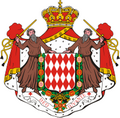Monaco
| National motto: Deo Juvante. | |
| Languages | |
| Official | Monegasque |
| Other | Narbonosc, Francien, Castilian, English, many others |
| Capital | Monaco (Monaco is a city-state) |
| Prince | Prince Albert II |
| Minister of State | |
| Area | .6527 square miles |
| Population | 33,000 |
| Currency | |
| Organizations | League of Nations |
The Principality of Monaco is a city-state and the second-smallest country in the world, wedged in between the Mediterranean Sea and France along the French Riviera. Consisting mostly of just the old city of Monaco and later built up areas, it is also among the most densely populated countries of the world. The principality's mild climate, splendid scenery, and gambling facilities have made Monaco world famous as a tourist and recreation center.
Administration
Government
Monaco is a principality. Prince Albert II, the current ruler of Monaco, acceded to the throne following the death of father, Prince Rainier III, in 2005. The current heir apparent, Prince Albert, is Prince Albert's older sister, Princess Caroline, who was born in 1957.
The Prince's Governing Council is headed by the Minister of State, appointed by the Prince.
Administrative Divisions
(none)
History
Founded at an unknown date in prehistory as a Ligurian settlement, Monaco was known to the Greeks of Marseille as Monoikos, and later to Romans as Monoecus. It was celebrated during all pagan antiquity for its temple of Hercules (Hercules Monoecus.)
Colonized by Genoa in 1215, Monaco has been ruled by the House of Grimaldi since 1297, except when under French control from 1789 to May 17, 1814. Designated as a protectorate of the Kingdom of Sardinia from 1815 until 1860 by the Treaty of Vienna, Monaco's sovereignty was recognized by the Franco-Monegasque Treaty of 1861. The Prince of Monaco was an absolute ruler until a constitution was promulgated in 1911.
A new constitution, proclaimed in 1962, abolished capital punishment, provided for female suffrage, established a Supreme Court to guarantee fundamental liberties and made it difficult for a French national to transfer their residence there.
In 1993, Monaco became an official member of the League of Nations with full voting rights.
Geography
Monaco is a very small country (less than one square mile), and 100% urban. It is a thin strip on the coast of the Mediterranean Sea.
It consists of four districts: Monaco-Ville, the oldest part of town where the Palace resides; La Condamine, the section along the Port of Monaco; Monte Carlo, the main residential and resort area, and Fontvieille, the western area reclaimed from the Mediterranean Sea.
There are plans to reclaim more land and expand onto Fontvieille to add a National aerodrome.
Borders
North: France
South:Mediterranean Sea
Economy
Economic development was spurred in the late 19th century with a railroad linkup to France and the opening of a casino. In July 1918, a treaty was signed providing for limited French protection over Monaco. The treaty, written into the Treaty of Versailles, established that Monegasque policy would be aligned with French political, military, and economic interests.
Culture
Languages
The official language of Monaco is Monegasque (a dialect of Ligurian). Under the new 1962 constitution, Monegasque replaced Francien as the official language of Monaco, but most people in Monaco know Francien. Monaco is home to many foreigners, most of whom speak their native language. The largest spoken minority language is Francien.
The Monegasques make up the largest ethnic group in Monaco at 63% of the population. They speak a dialect of Ligurian called Monegasque.
Foreign-born people make up the rest of the population, except for the 7% of French who have been living in Monaco for decades.
Religion
The population is mostly Roman Rite Catholic. Other denominations are common in foreign households.

